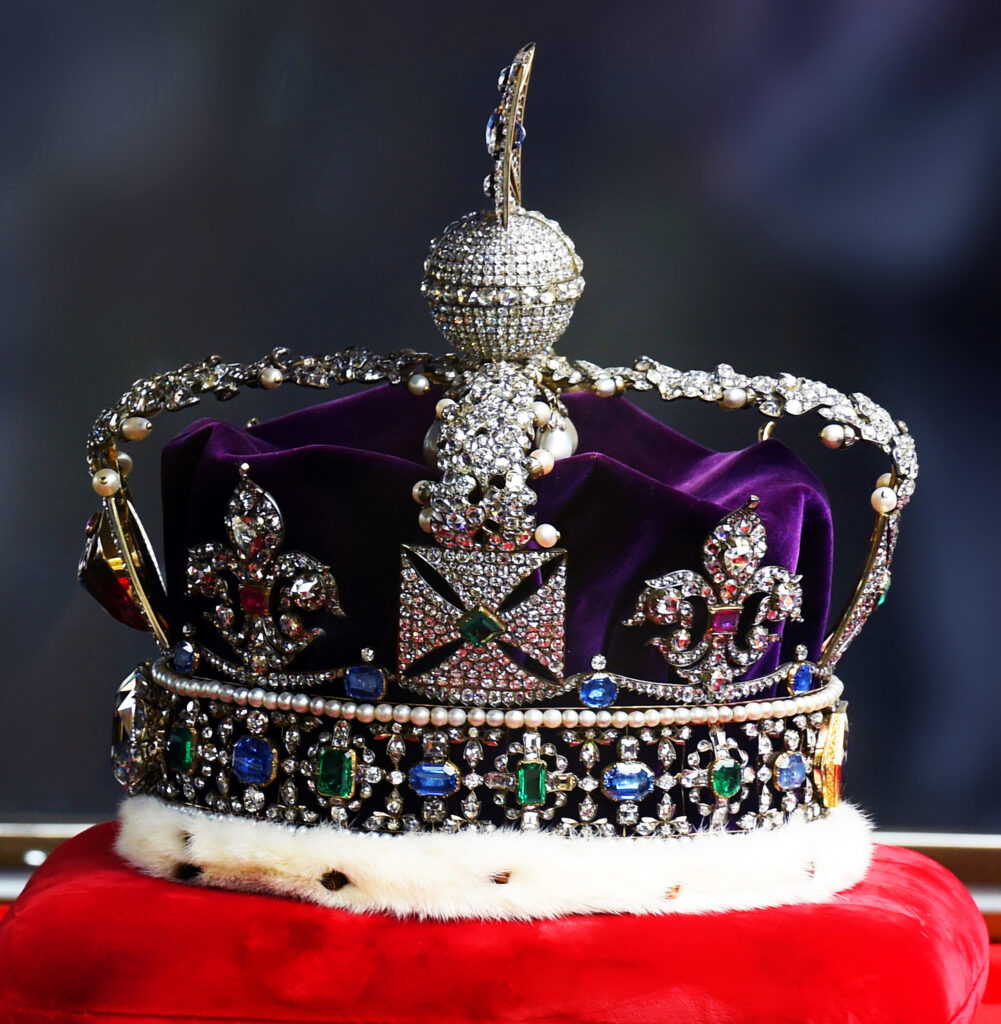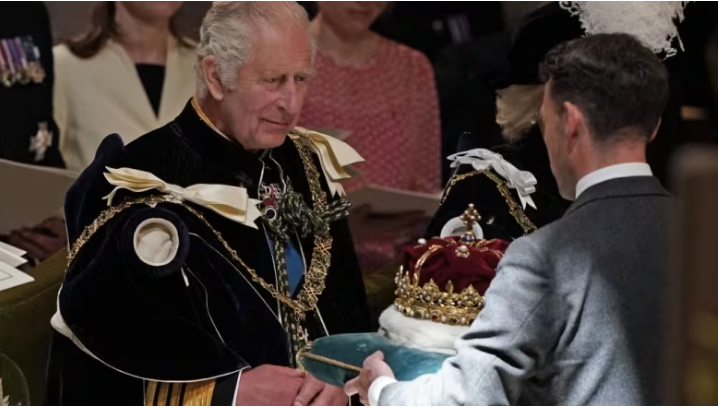
King Charles is presented with the Crown of Scotland during a service at St. Giles’ Cathedral in Edinburgh on July 5. ( Andrew Milligan/Getty Images)
Scottish crown jewels presented to monarch during service in Edinburgh to mark coronation
Two months after his coronation, King Charles was presented with another crown.
As much as that Crown of Scotland carried with it centuries of royal symbolism, the ceremony that surrounded the presentation of the Scottish crown jewels to him in Edinburgh a few days ago also reflected efforts to send signals about the monarchy’s future in that corner of the United Kingdom.
Ewen Cameron, a professor of Scottish history at the University of Edinburgh, saw careful efforts to send two distinct messages from the service held at St. Giles’ Cathedral to mark the coronation.
“They wanted to send this message: You know, we take Scotland seriously. We recognize what contemporary Scotland is all about,” Cameron said in an interview.
“But also … they wanted to send a reminder of the Scottishness of the monarchy.”
That Scottishness has deep historic roots — the crown, for example, was made for King James V, and he wore it for the first time in 1540, at the coronation of Queen Mary of Guise. But the actual ceremony last week is, in royal terms, a relatively new phenomenon.
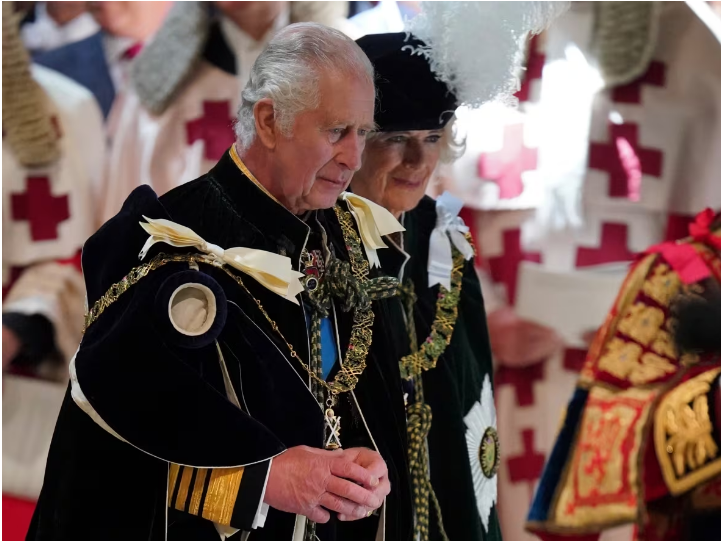
King Charles, left, and Queen Camilla arrive for the presentation of the Honours of Scotland at St. Giles’ Cathedral. (Jonathan Brady/The Associated Press)
“In some ways, it doesn’t have very deep historical roots,” said Cameron, who noted that while Charles’s mother, Queen Elizabeth, did something similar in 1953, after her coronation, her father, King George VI, and three previous monarchs did not.
As Elizabeth came to the throne, there were some particular considerations.
“It was tricky in 1953 because that was an era when … early Scottish nationalism was beginning to develop,” Cameron said. “Not really in an electoral sense. The [Scottish National Party] weren’t very successful at elections, but there was a broad sort of cultural movement, feeling around that Scotland wasn’t quite getting its just recognition within the union.”
As much as it was a royal ceremony in 1953, there were efforts to ensure it didn’t have the full flavour of a coronation. The Queen came in regular day dress rather ceremonial robes.
“They wanted the Queen to be seen in Scotland to kind of respond to this feeling,” said Cameron. “But they didn’t want to go too far and have anything that looked like a coronation, because that might feed the very nationalism that they were seeking to kind of manage.”
However delicate that balance was in 1953, Cameron sees it more so in 2023.
Scotland marked the coronation of King Charles and his wife Camilla, presenting him with the “Honours of Scotland,” Britain’s oldest crown jewels.
“It’s even trickier now because, of course, Scotland’s position has changed,” he said.
“We have a Parliament here in Edinburgh, which is devolved,” Cameron said.
“And of course we also have an SNP government, or SNP working with the Green Party. And of course both of those parties want independence for Scotland.”
This time around, there was a bit more to the ceremony.
“What we saw last week was a kind of development of what had been done in ’53,” said Cameron. “The King … he didn’t just turn up in his blue double-breasted [suit] … he was in some sort of regalia.”
The Stone of Destiny, also known as the Stone of Scone, was there this time, but Charles wasn’t sitting too close to it, Cameron noted.
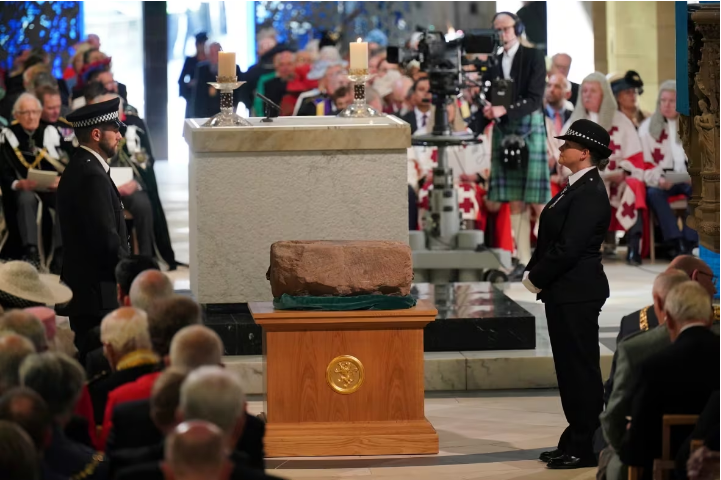
Officers guard the Stone of Destiny, also known as the Stone of Scone, ahead of the service. (Jonathan Brady/The Associated Press)
“So they’re trying to manage this. You know, it’s not a coronation, it’s something else,” he said. “It’s about recognizing … a degree of Scottishness in terms of what the monarchy stands for.”
Coronation expert George Gross said that being presented with Scotland’s crown would have been especially significant for Charles.
“Less than a year ago, the King had been standing paying vigil with his late mother lying in rest in St. Giles’ Cathedral, with that same crown on top of the coffin,” said Gross, a visiting research fellow at King’s College London. “That was a very poignant moment.”
Outside the cathedral last week, republicans who want to abolish the monarchy waged their own protest.
“This pointless vanity parade in Edinburgh will cost Scottish taxpayers millions of pounds, and for what?” Graham Smith, CEO of the group Republic, said in a news release. “So Charles can once again be centre of attention for a day.”
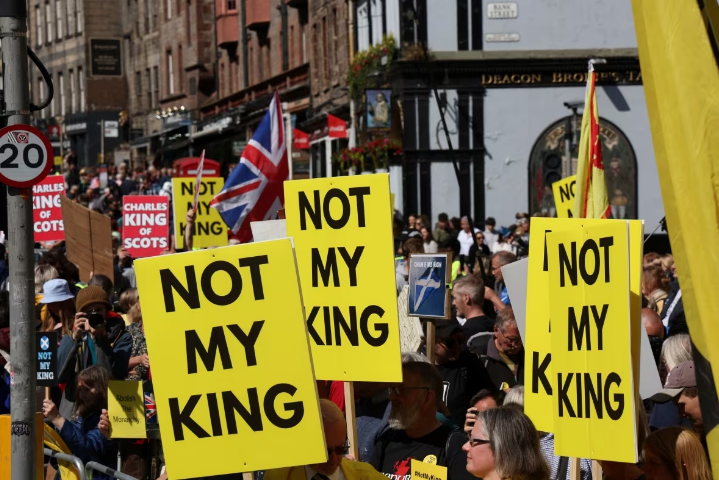
Anti-monarchy protesters and royal supporters gather near St. Giles’ Cathedral in Edinburgh on July 5. (Russell Cheyne/The Associated Press)
Cameron said he was struck by the fact that the protesters “were given a very prominent position” close to the door of the cathedral.
“There didn’t seem to be any of the heavy-handed tactics that were present last summer or indeed at the time of the coronation in London, where the Metropolitan Police had a lot of criticism for the way that it handled the republicans.”
Along with King Charles and Queen Camilla, Charles’s heir, Prince William, and Catherine, Princess of Wales, were on hand as Charles was presented with the crown jewels. Cameron found it interesting they were so prominent.
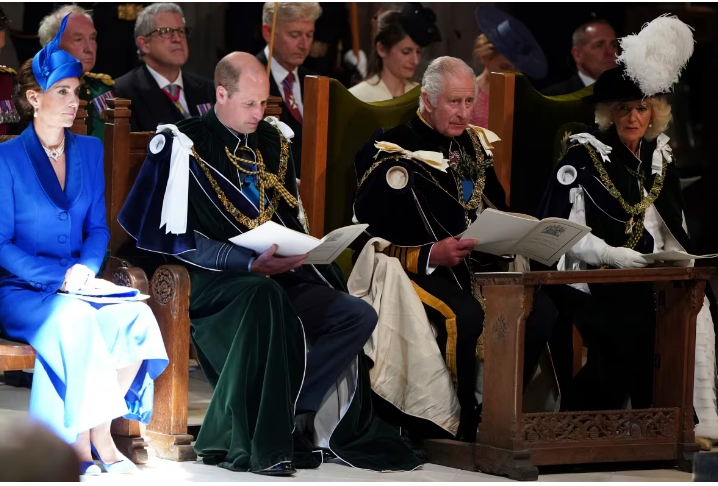
From left, Catherine, Princess of Wales, Prince William, King Charles and Queen Camilla take part in the service. (Andrew Milligan/The Associated Press)
“It seems to me that that generation of the Royal Family are … less keen to play the Scottish cards, if you like, than their father or especially their grandmother, the late Queen,” he said. “You don’t see Prince William very often wearing a kilt, for example.”
Seeing William and Catherine along for this ceremony left Cameron wondering if it was “an attempt to … introduce them to that side of royal tradition, to inculcate them into, you know, what needs to be done as far as Scotland is concerned.”
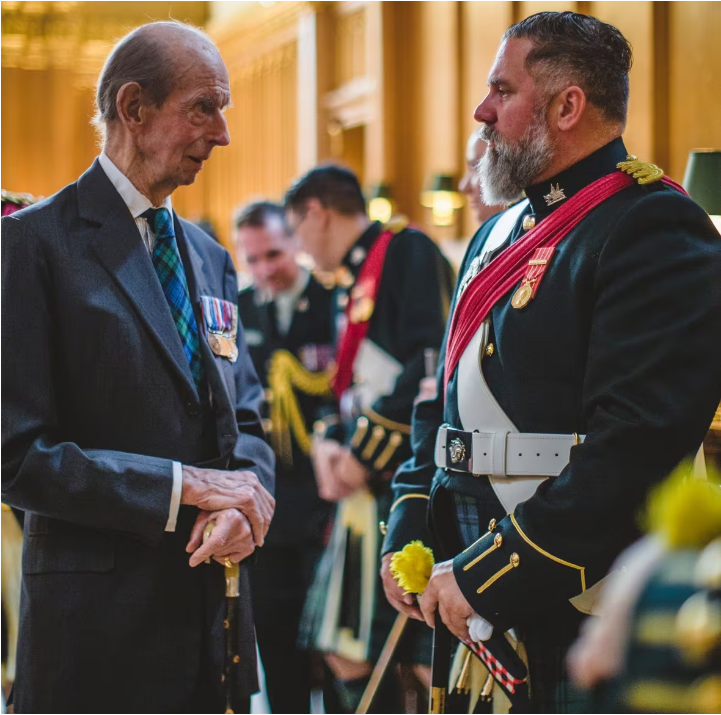
The Duke of Kent, left, speaks to Chief Warrant Officer Anthony Crawford, regimental sergeant major of the Lorne Scots, inside the Chapel Royal at St. James’s Palace in London on June 28, after the regimental drums were dedicated to the duke. (Varun Virwani/Lorne Scots)
The army reservists from the Greater Toronto Area were settling into their airplane seats recently, anticipating their flight to London to see their royal colonel in chief.
Even though the members of the Lorne Scots (Peel, Dufferin and Halton Regiment) were securely aboard and looking forward to meeting with the Duke of Kent, there was a lingering concern. Things can disappear during air travel, so would the gear that was key to their royal visit make it onto the plane with them?
But then, as one of the reservists was looking out the window, the oversized and awkwardly shaped cargo marked “Fragile, this way up” was spotted being loaded onto the plane.
That cargo was the regimental drums of the Lorne Scots, a reserve unit based in communities to the west and north of Toronto.
Those drums were at the heart of the trip to London, as they were dedicated during a service at St. James’s Palace to the Duke of Kent, Prince Edward, in recognition of his commitment as the regiment’s longest-serving colonel in chief.
The idea of holding a dedication of the drums came about during planning for the upcoming presentation of new colours for the Lorne Scots. That is set for this fall, and traditionally would be done in the presence of the colonel in chief.
But at age 87, the duke, Queen Elizabeth’s cousin, no longer has overseas travel on his agenda.
“We got to speaking with his staff because he’s been our colonel in chief for a long, long time … since 1977,” Lt.-Col. Robert Fraser, the regiment’s commanding officer, said in an interview.
The duke had presented the regiment’s current colours to them in the early 1990s, and “very much wanted to … do something with us,” Fraser said.
Still, there was the question — what might that something be? And where could it take place?
“We thought … knowing he can’t come to us, we [can go] to him,” Fraser said.
“We got to discussing it and we talked about, ‘Well, why don’t we dedicate our drums, so we can go over there, conduct a drumhead ceremony and then bless the drums as the Duke of Kent drums.’ And then in perpetuity, we’ll always have them, and that way we’re always going to have that connection to the duke.”
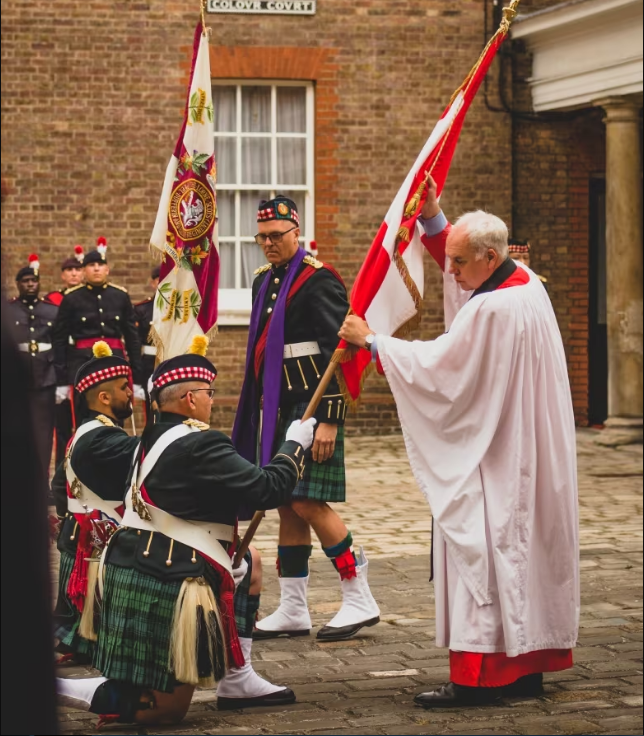
Coupland, centre, and Wright, right, receive the Lorne Scots’ regimental colours from colour officers Capt. Alexander McKelvey and Capt. Yousef Jamal before they are placed on top of the regimental drums to form an altar. (Varun Virwani/Lorne Scots)
About 20 soldiers, along with a few former commanding and serving officers, flew to London late last month. Once there, some quick rehearsing was in order for the ceremony, which also involved members of the Lorne Scots’ allied regiment in the British Army, the 1st Battalion, Royal Regiment of Fusiliers.
For the dedication, the Lorne Scots’ colours were placed over the stacked drums and a service was conducted by their padre, Capt. Kevin Coupland, and Rev. Paul Wright, domestic chaplain to King Charles.
“No more fitting place could be found to recognize these emblems of duty and of service than this Chapel Royal, where praise, prayer and acts of devotion and dedication are made,” Coupland said in a news release.
After the ceremony and a parade, there was a small, private reception where some soldiers from the Lorne Scots and the Fusiliers met the duke, and he presented awards.
Fraser said the duke was in good spirits and “very engaged in talking to the soldiers,” asking a lot of questions about how the regiment is doing and how preparation is coming along for the presentation of the colours in the fall.
The ceremony offered members of the Lorne Scots a unique experience, Fraser said.
“For I think some of the soldiers … that had that private audience with the duke … those are lifelong memories they’re going to have and that’ll get passed down not only on the regimental family side, but within their families as well.”
Having the links to the duke is also significant for the regiment, Fraser said.
“Remembering those connections that you have and those ties are important because it really ties into regimental identity and who we are.”
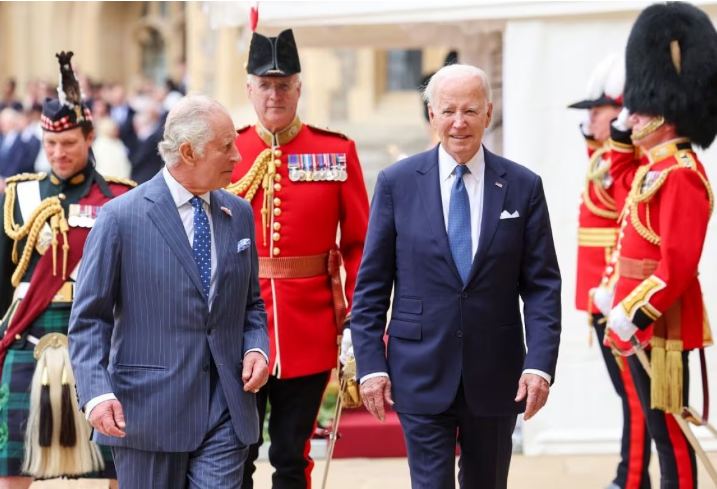
King Charles, left, walks with U.S. President Joe Biden in the quadrangle of Windsor Castle in Windsor, England, after a ceremonial welcome on Monday. (Chris Jackson/AFP/Getty Images)
There were the smiles and handshakes that are de rigueur for royal visits, but the brief stop U.S. President Joe Biden made at Windsor Castle the other day also gave him and King Charles a chance to talk about a subject of concern for both men: climate change.
“The meticulously choreographed gathering at Windsor Castle injected substance into the type of encounter between president and monarch that historically has been more about ceremony,” The Associated Press reported of the get-together.
Prior to Charles’s coronation in May, much was made in some corners of the media about the fact that Biden would not be attending (even though previous U.S. presidents have also been absent from such occasions).
Biden’s visit earlier this week came during a stopover on his way to the NATO summit in Lithuania. He also sat down for tea with British Prime Minister Rishi Sunak in the garden at 10 Downing Street.
The meeting at Windsor Castle was the latest get-together between the U.S. leader and the monarch, and served as an opportunity for those watching to try to assess the status of the “special relationship” between the two countries.
“The King and President Joe Biden were all smiles and warm handshakes as the U.K.-U.S. special relationship looked to be on a firm footing,” the Independent reported.

